MITSUBISHI COLT 2008 Owner's Manual (in English)
Manufacturer: MITSUBISHI, Model Year: 2008, Model line: COLT, Model: MITSUBISHI COLT 2008Pages: 450, PDF Size: 14.57 MB
Page 291 of 450
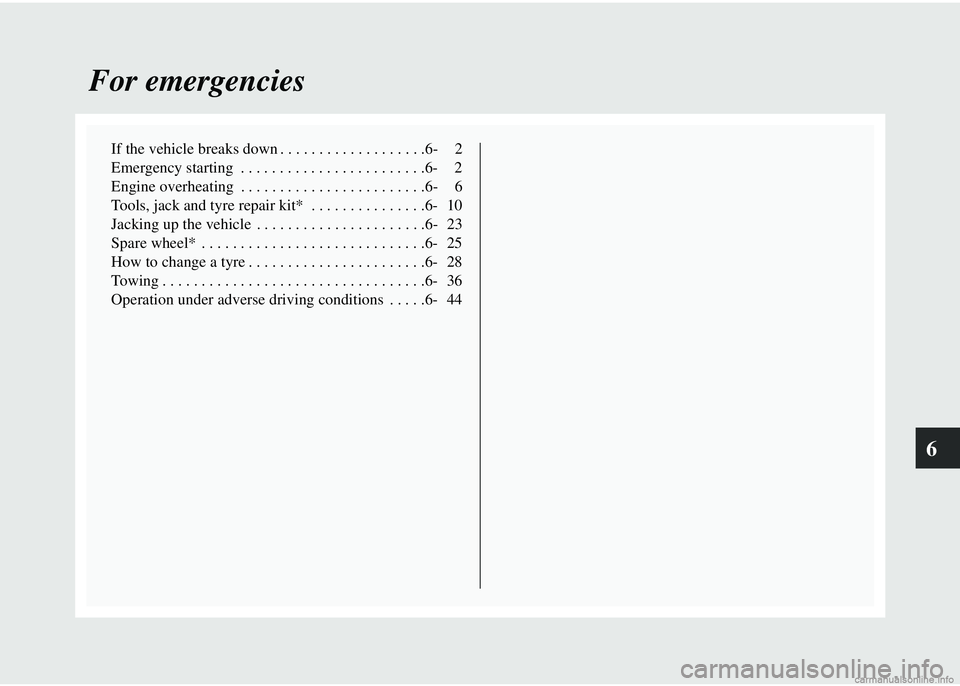
6
For emergencies
If the vehicle breaks down . . . . . . . . . . . . . . . . . . .6- 2
Emergency starting . . . . . . . . . . . . . . . . . . . . . . . .6- 2
Engine overheating . . . . . . . . . . . . . . . . . . . . . . . .6- 6
Tools, jack and tyre repair kit* . . . . . . . . . . . . . . .6- 10
Jacking up the vehicle . . . . . . . . . . . . . . . . . . . . . .6- 23
Spare wheel* . . . . . . . . . . . . . . . . . . . . . . . . . . . . .6- 25
How to change a tyre . . . . . . . . . . . . . . . . . . . . . . .6- 28
Towing . . . . . . . . . . . . . . . . . . . . . . . . . . . . . . . . . .6- 36
Operation under adverse driving conditions . . . . .6- 44
Page 292 of 450
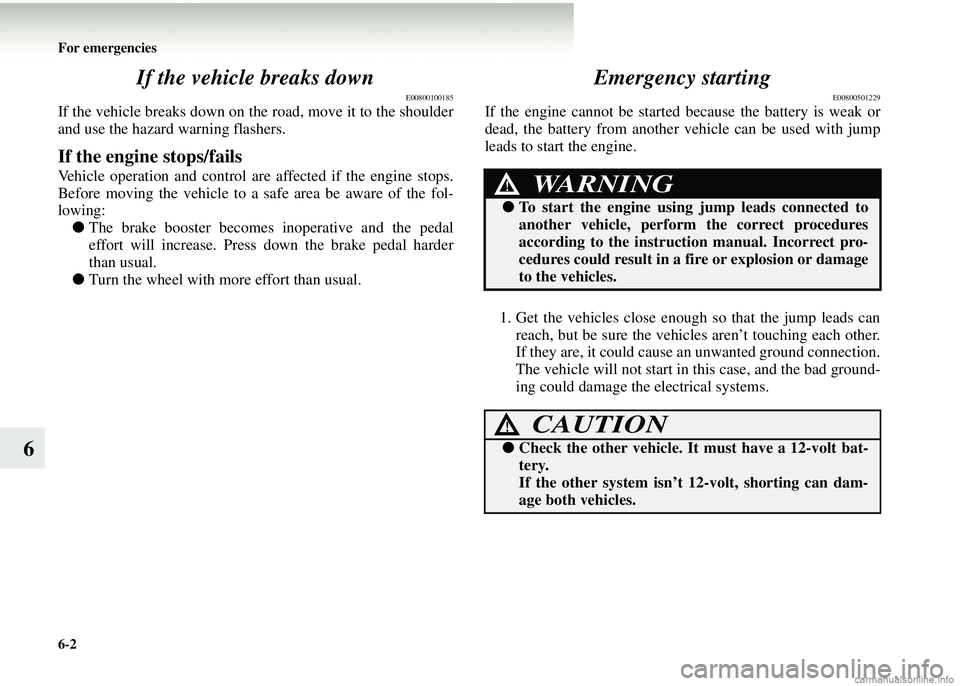
6-2 For emergencies
6If the vehicle breaks down
E00800100185
If the vehicle breaks down on th
e road, move it to the shoulder
and use the hazard warning flashers.
If the engine stops/fails
Vehicle operation and control are affected if the engine stops.
Before moving the vehicle to a safe area be aware of the fol-
lowing: ● The brake booster becomes inoperative and the pedal
effort will increase. Press down the brake pedal harder
than usual.
● Turn the wheel with more effort than usual.
Emergency starting
E00800501229
If the engine cannot be started because the battery is weak or
dead, the battery from another vehicle can be used with jump
leads to start the engine.
1. Get the vehicles close enoug h so that the jump leads can
reach, but be sure the vehicles aren’t touching each other.
If they are, it could cause an unwanted ground connection.
The vehicle will not start in this case, and the bad ground-
ing could damage the electrical systems.
WARNING!
● To start the engine using jump leads connected to
another vehicle, perfor m the correct procedures
according to the instruct ion manual. Incorrect pro-
cedures could result in a fire or explosion or damage
to the vehicles.
CAUTION!
● Check the other vehicle. It must have a 12-volt bat-
tery.
If the other system isn’t 12-volt, shorting can dam-
age both vehicles.
Page 293 of 450
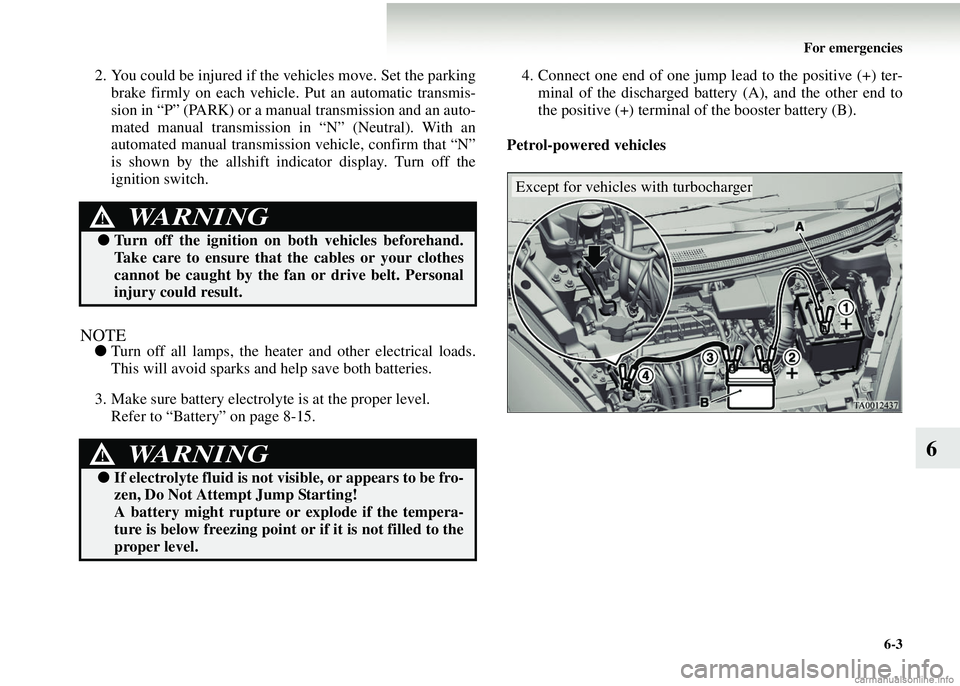
For emergencies6-3
6
2. You could be injured if the vehicles move. Set the parkingbrake firmly on each vehicle. Put an automatic transmis-
sion in “P” (PARK) or a manua l transmission and an auto-
mated manual transmission in “N” (Neutral). With an
automated manual transmission vehicle, confirm that “N”
is shown by the allshift indicator display. Turn off the
ignition switch.
NOTE● Turn off all lamps, the heater and other electrical loads.
This will avoid sparks and help save both batteries.
3. Make sure battery electrolyte is at the proper level. Refer to “Battery” on page 8-15. 4. Connect one end of one jump lead to the positive (+) ter-
minal of the discharged battery (A), and the other end to
the positive (+) terminal of the booster battery (B).
Petrol-powered vehicles
WARNING!
● Turn off the ignition on both vehicles beforehand.
Take care to ensure that the cables or your clothes
cannot be caught by the fan or drive belt. Personal
injury could result.
WARNING!
● If electrolyte fluid is not vi sible, or appears to be fro-
zen, Do Not Attempt Jump Starting!
A battery might rupture or explode if the tempera-
ture is below freezing point or if it is not filled to the
proper level.
Except for vehicles with turbocharger
Page 294 of 450
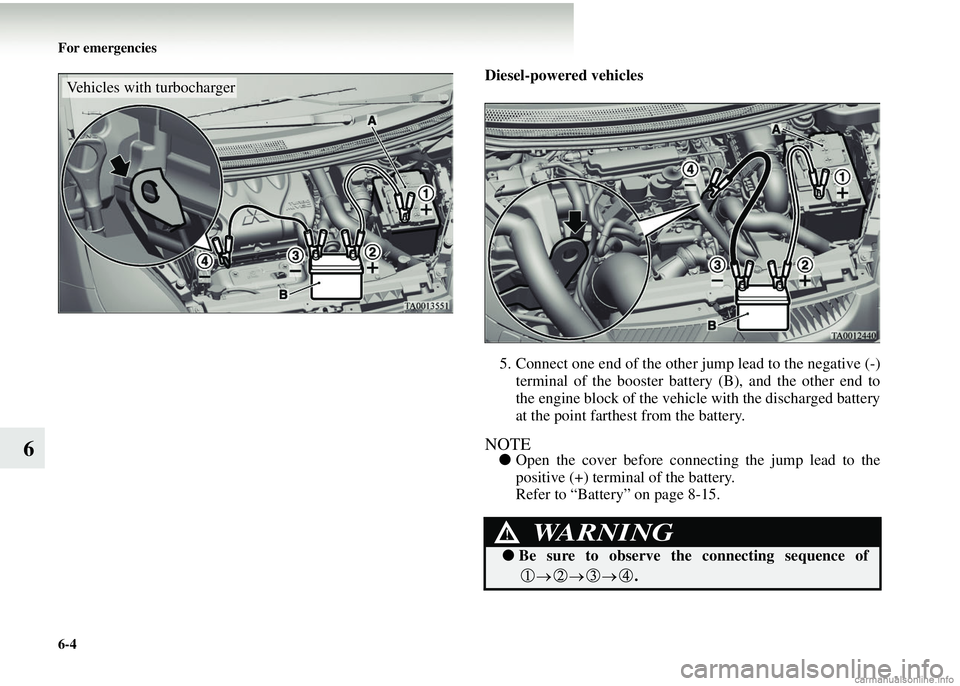
6-4 For emergencies
6
Diesel-powered vehicles
5. Connect one end of the other jump lead to the negative (-) terminal of the booster battery (B), and the other end to
the engine block of the vehicl e with the discharged battery
at the point farthest from the battery.
NOTE● Open the cover before connec ting the jump lead to the
positive (+) terminal of the battery.
Refer to “Battery” on page 8-15.
Vehicles with turbocharger
WARNING!
● Be sure to observe the connecting sequence of
→→→ .
Page 295 of 450
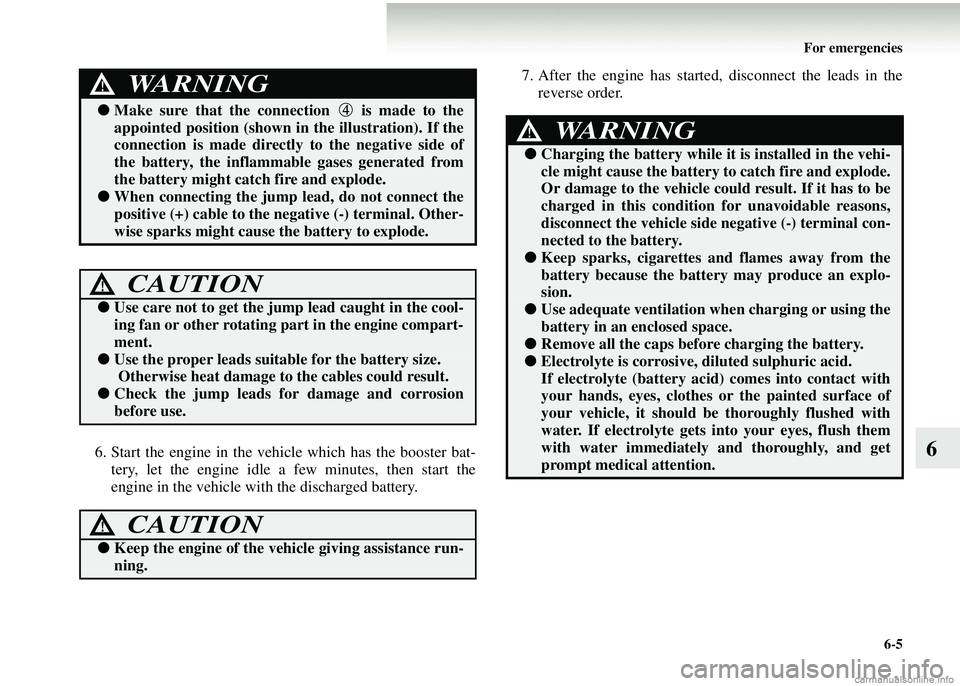
For emergencies6-5
66. Start the engine in the vehicle which has the booster bat-tery, let the engine idle a few minutes, then start the
engine in the vehicle with the discharged battery. 7. After the engine has started, disconnect the leads in the
reverse order.
● Make sure that the conn ection is made to the
appointed position (shown in the illustration). If the
connection is made directly to the negative side of
the battery, the inflammable gases generated from
the battery might catch fire and explode.
● When connecting the jump lead, do not connect the
positive (+) cable to the ne gative (-) terminal. Other-
wise sparks might cause the battery to explode.
CAUTION!
●Use care not to get the jump lead caught in the cool-
ing fan or other rotating part in the engine compart-
ment.
● Use the proper leads suitable for the battery size.
Otherwise heat damage to the cables could result.
●Check the jump leads for damage and corrosion
before use.
CAUTION!
●Keep the engine of the ve hicle giving assistance run-
ning.
WARNING!
WARNING!
● Charging the battery while it is installed in the vehi-
cle might cause the battery to catch fire and explode.
Or damage to the vehicle could result. If it has to be
charged in this condition for unavoidable reasons,
disconnect the vehicle side negative (-) terminal con-
nected to the battery.
● Keep sparks, cigarettes an d flames away from the
battery because the battery may produce an explo-
sion.
● Use adequate ventilation when charging or using the
battery in an enclosed space.
●Remove all the caps before charging the battery.
●Electrolyte is corrosive, diluted sulphuric acid.
If electrolyte (battery ac id) comes into contact with
your hands, eyes, clothes or the painted surface of
your vehicle, it should be thoroughly flushed with
water. If electrolyte gets into your eyes, flush them
with water immediately and thoroughly, and get
prompt medical attention.
Page 296 of 450
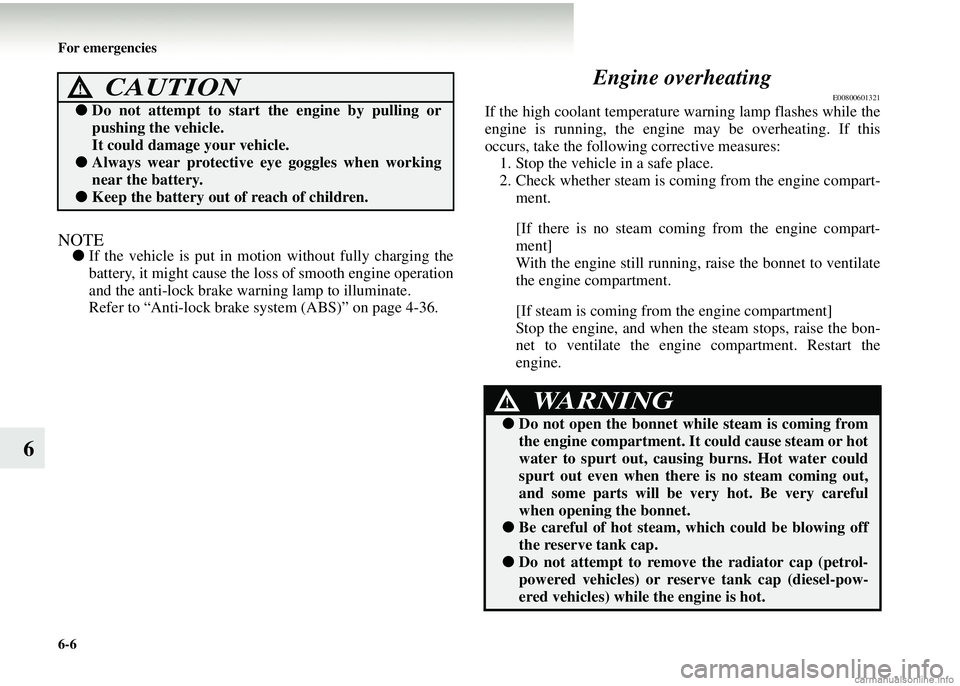
6-6 For emergencies
6
NOTE●If the vehicle is put in motion without fully charging the
battery, it might cause the loss of smooth engine operation
and the anti-lock brake warning lamp to illuminate.
Refer to “Anti-lock brake system (ABS)” on page 4-36.
Engine overheating
E00800601321
If the high coolant temperature warning lamp flashes while the
engine is running, the engine may be overheating. If this
occurs, take the follow ing corrective measures:
1. Stop the vehicle in a safe place.
2. Check whether steam is comin g from the engine compart-
ment.
[If there is no steam comi ng from the engine compart-
ment]
With the engine still running, raise the bonnet to ventilate
the engine compartment.
[If steam is coming from the engine compartment]
Stop the engine, and when the steam stops, raise the bon-
net to ventilate the engine compartment. Restart the
engine.
CAUTION!
● Do not attempt to start the engine by pulling or
pushing the vehicle.
It could damage your vehicle.
●Always wear protective eye goggles when working
near the battery.
●Keep the battery out of reach of children.
WARNING!
●Do not open the bonnet wh ile steam is coming from
the engine compartment. It could cause steam or hot
water to spurt out, causin g burns. Hot water could
spurt out even when there is no steam coming out,
and some parts will be very hot. Be very careful
when opening the bonnet.
●Be careful of hot steam, which could be blowing off
the reserve tank cap.
●Do not attempt to remove the radiator cap (petrol-
powered vehicles) or res erve tank cap (diesel-pow-
ered vehicles) while the engine is hot.
Page 297 of 450
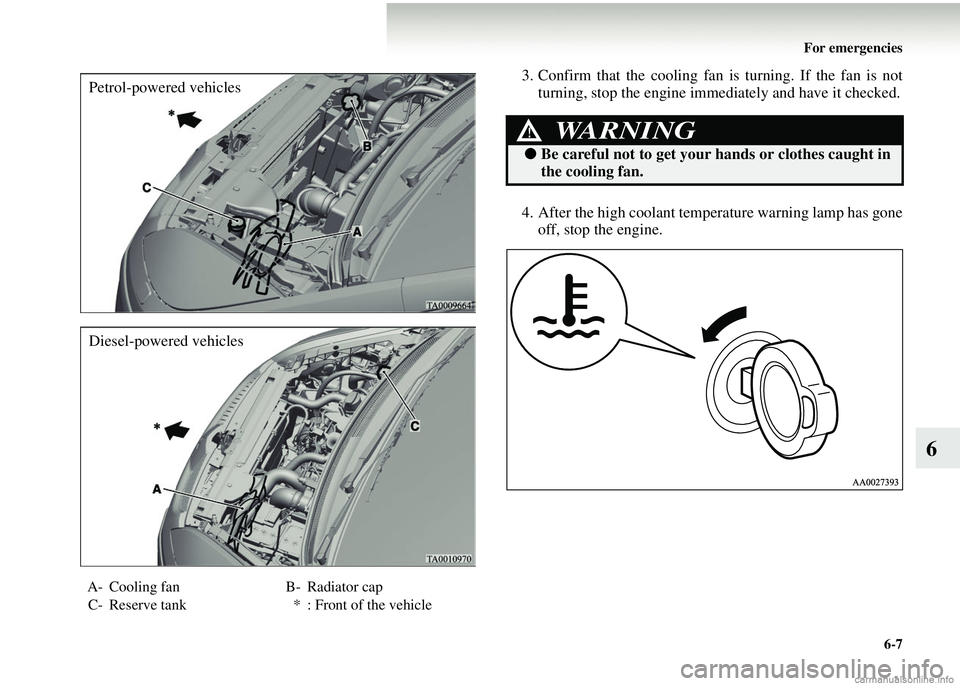
For emergencies6-7
6
3. Confirm that the cooling fan is turning. If the fan is notturning, stop the engine im mediately and have it checked.
4. After the high coolant temp erature warning lamp has gone
off, stop the engine.
A- Cooling fan B- Radiator cap
C- Reserve tank * : Front of the vehicle
Petrol-powered vehicles
Diesel-powered vehicles
WARNING!
●Be careful not to get your hands or clothes caught in
the cooling fan.
Page 298 of 450
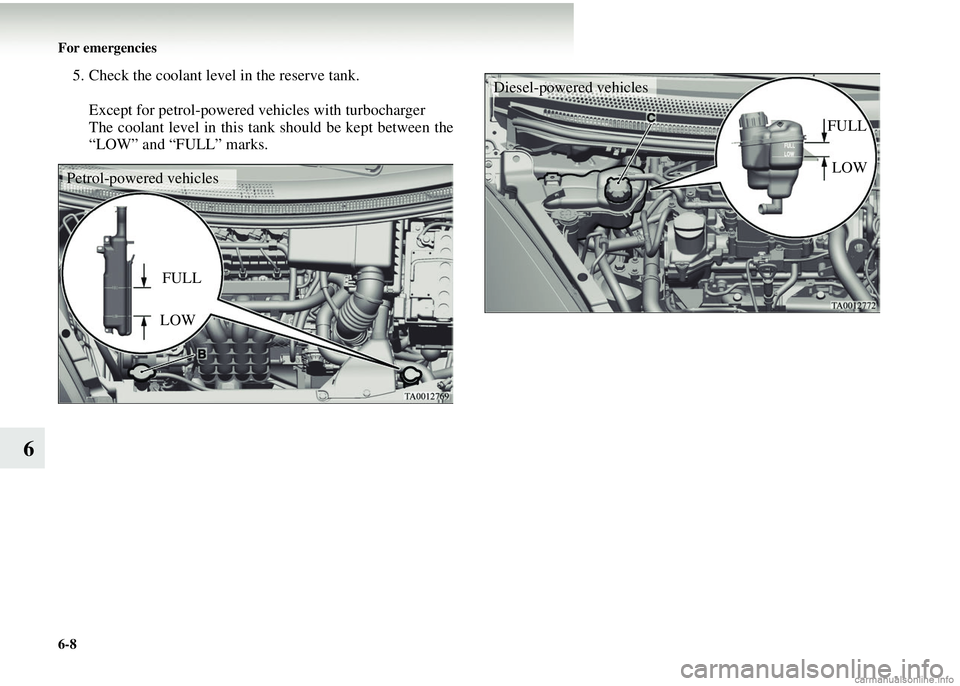
6-8 For emergencies
6
5. Check the coolant level in the reserve tank.Except for petrol-powered ve hicles with turbocharger
The coolant level in this tank should be kept between the
“LOW” and “FULL” marks.
FULL
LOW
Petrol-powered vehicles
Diesel-powered vehicles
FULL
LOW
Page 299 of 450
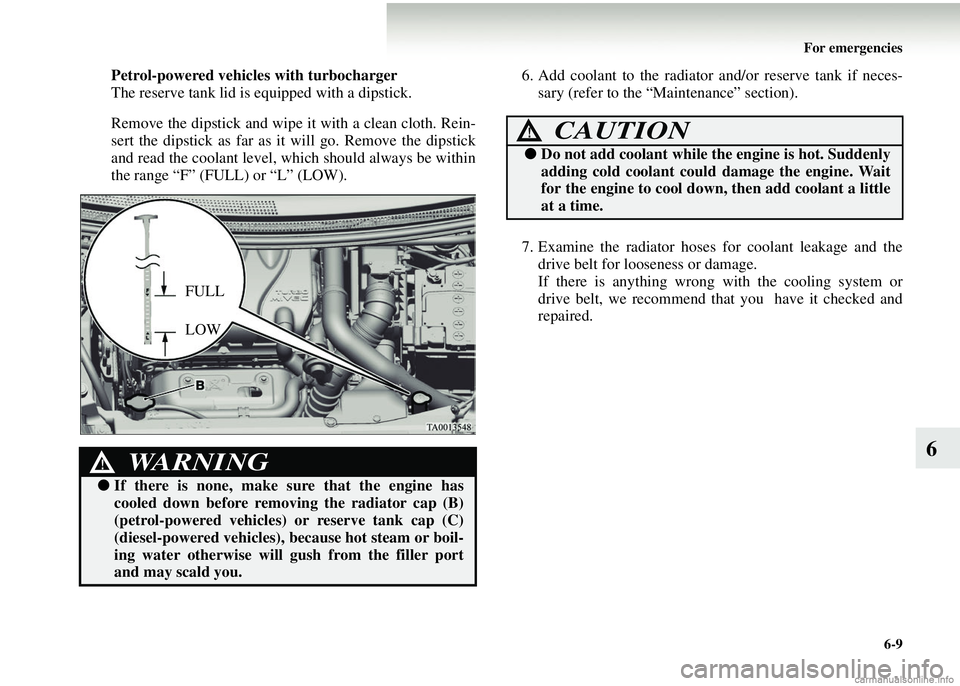
For emergencies6-9
6
Petrol-powered vehicles with turbocharger
The reserve tank lid is equipped with a dipstick.
Remove the dipstick and wipe it with a clean cloth. Rein-
sert the dipstick as far as it will go. Remove the dipstick
and read the coolant level, which should always be within
the range “F” (FULL) or “L” (LOW). 6. Add coolant to the radiator
and/or reserve tank if neces-
sary (refer to the “Maintenance” section).
7. Examine the radiator hoses for coolant leakage and the drive belt for looseness or damage.
If there is anything wrong with the cooling system or
drive belt, we recommend that you have it checked and
repaired.
WARNING!
● If there is none, make sure that the engine has
cooled down before removi ng the radiator cap (B)
(petrol-powered vehicles) or reserve tank cap (C)
(diesel-powered vehicles), because hot steam or boil-
ing water otherwise will gush from the filler port
and may scald you.
FULL
LOW
CAUTION!
● Do not add coolant while the engine is hot. Suddenly
adding cold coolant coul d damage the engine. Wait
for the engine to cool down, then add coolant a little
at a time.
Page 300 of 450
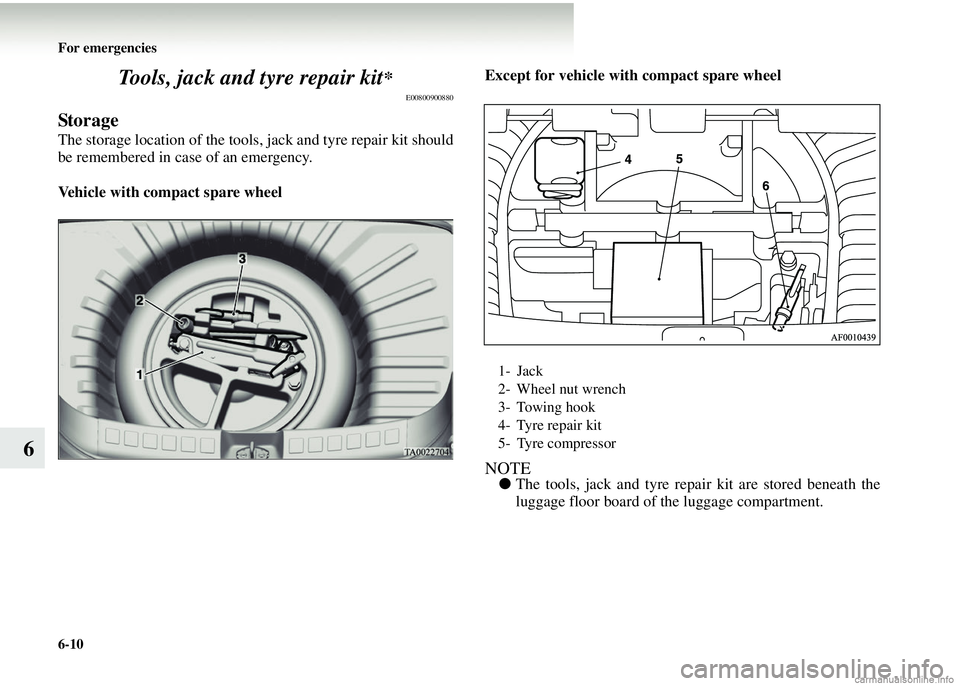
6-10 For emergencies
6Tools, jack and tyre repair kit
*
E00800900880
Storage
The storage location of the tools, jack and tyre repair kit should
be remembered in case of an emergency.
Vehicle with compact spare wheel
Except for vehicle with compact spare wheel
NOTE● The tools, jack and tyre repair kit are stored beneath the
luggage floor board of the luggage compartment.
1- Jack
2- Wheel nut wrench
3- Towing hook
4- Tyre repair kit
5- Tyre compressor